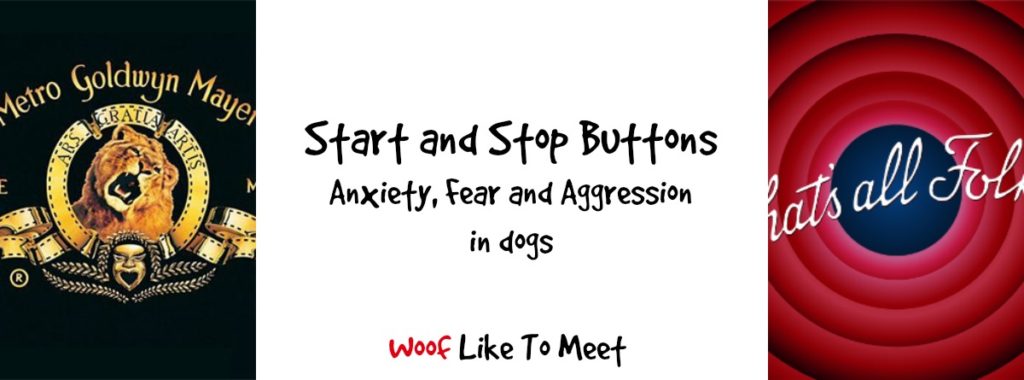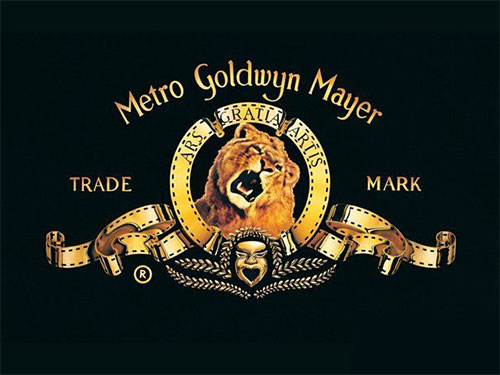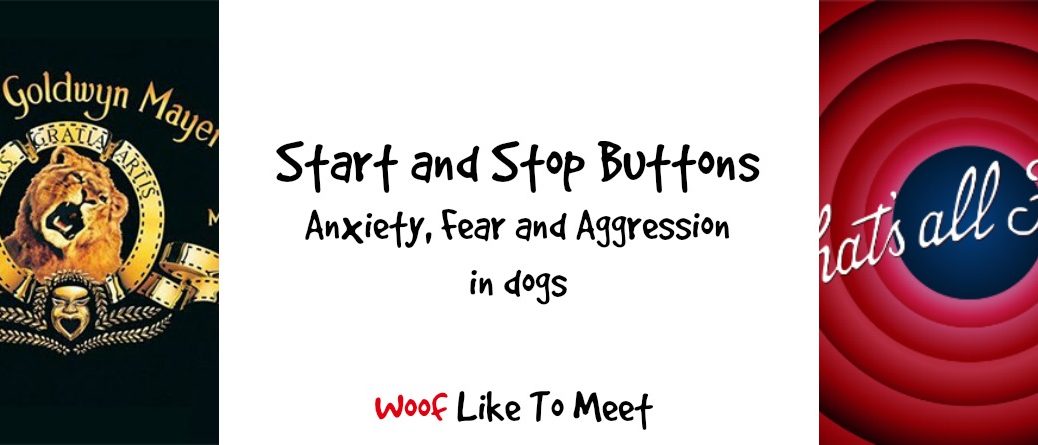
When we discuss behaviour, we so often talk about the behavioural triggers, the ‘on’ buttons that say, ‘Go! Go! Go!’
Without those ‘on’ buttons, those behaviours would just be spilling out willy-hilly, hither and thither. Our dogs would bark for no reason. Growls really would come from nowhere. Bouncy labradors would bounce with the random whimsy of a cartoon puppet. Those ‘on’ buttons, sometimes known as triggers, put the edges in. They are the fanfare that announce that the performance of the behaviour is about to start. It’s the MGM lion that says, “Show’s about to start, people!”

That’s what I love about behaviour: the buttons. The triggers. The antecedents. The environmental cues that say, ‘Now would be a REALLY good time to do that thing you do!’. Behaviourists are in the business of finding the fanfare. We’re looking for the MGM lions that announce a behaviour will be required.
That’s logical. Behaviour doesn’t just spill out of us randomly.
As behaviourists, we’re obsessed by the starter guns, the triggers. The cars that lead to arousal. The appearance of a squirrel that leads to chasing. The presentation of a toy that leads to play sessions. The appearance of another dog that leads to barking and lunges. Find the trigger, you can desensitise. You can counter-condition. You can work out the emotional drivers behind the behaviour. You could, if you wanted, arrange the environment so that the MGM lion never appears ever again to say that a behaviour is required.
Our dogs are obsessed by our starter cues and fanfares as well. The way you brush your teeth immediately before a walk. The way you get bowls out right around 5pm. The sound of a van that means the post lady is in town. Boots on, walkies. Doorbells and knockers that announce visitors. Standing up and moving near the refrigerator.
We talk all the time about those triggers, those fanfares that announce the performance of the behaviour is imminent. Pavlov was obsessed with them. Metronomes. People in white coats. Footsteps …. he gave us a very nice phrase for them: conditioned and unconditioned stimuli. Nicer than fanfares and MGM lions and triggers and cues and antecedents and signals and a whole dictionary of confusing metaphors.
Cialdini in his book Influence said these stimuli, antecedents, cues or triggers tell the brain ‘do this now’ and set off an automatic chain of events leading to a behaviour or biological change. He called the stimuli the ‘click’ and the behaviour the ‘whirr’ as if the environment presses a button and behaviour clicks into play mode. We chimps love our metaphors.
I think that notion is pretty well dissected and described in the animal training world. There are lots of metaphors we use for the stimuli that create the ideal stage for a behaviour to be performed upon, that announce performance is about to start.
But what tells behaviour to stop? What says, ‘No point…. pack it in.’ What brings the curtains down? What says “That’s all, folks!”

Usually that is when the function of the behaviour has been met or we see it is unlikely to be met. The behaviour met its goal: success. The behaviour was ineffective: failure.
This is what I care about. Triggers and stimuli are all well and good but I care about what turns the behaviour off again. The fact is if behaviour exists, by and large it exists because once upon a time it was useful. It may even be useful even now. It may be so very successful that it’s the immediate go-to behaviour to achieve that result. Where behaviour fails to achieve that result, it tends to die out. No point.
So I want to know when the behaviour stops, as that tells me what is keeping it alive. What are the consequences that lead to repeat performances?
For me, what makes me stop running for a departing bus? (Apart from a mild heart attack?)
There are only two real-life consequences. I either catch the bus or know that catching the bus is impossible. Success or failure. If I succeed, I’m more likely to choose that behaviour in the same circumstances in the future. If it fails, I’m less likely.
But success or failure is an immediate thing.
What makes the running stop? I mean I’m not Forrest Gump. I don’t keep running. Or I’m not running on the bus when I get it. At some point, I quit. What makes that behaviour say, ‘That’s all, folks!’
That’s what I care about. When does the behaviour stop? Because when it does, that’s highly probable to be your reinforcer – the result that keeps the behaviour alive and makes it a reliable choice for success.
What makes Flika bark?
The increasing noise of planes in the sky.
What makes it stop? At what point does it actually stop?
The plane either goes away, or she realises her barking is not influencing the noise. Usually the former. Success (in her eyes anyway). Today, she very effectively (in her eyes anyway) told a low-flying plane to sod off. She barked, and as the plane sound got less loud, she stopped. The thing keeping the behaviour alive is that barking clearly makes airborne noises go away. Success.
What makes Heston bark?
The sound of the post lady’s van slowing down outside our gate.
What makes him increase that barking? Her getting out of the van.
What makes the barking decrease? The post lady going away. Success.
What is the moment at which it stops? When the post lady drives off.
We don’t talk about those off-switches enough, in my opinion. Success fuels the continuation of that behaviour. It marks it as a potentially useful action to get success in the future. It makes it more likely to happen again.
Those off-switches or consequences tell us what the function of the behaviour is. Why it’s necessary. They tell us what the dog wants. They tell us when the dog thinks it’s being effective. What did the behaviour succeed at doing? What happened as a result? What were the consequences?
I love this. It’s so non-invasive and observational. It tells us all about motivation. I don’t need MRI scanners to see that. I don’t need to make up fictional reasons to explain their motivation. I can see really clearly what’s fuelling the behaviour.
If the behaviour increases in the future, the function of the behaviour was met the last time, and it’s more likely to happen again in order to bring about the same result.
The cue, stimulus or trigger simply says WHEN. It says ‘DO THAT THING NOW!’
That’s all.
When the behaviour stops or decreases is the important bit, as it tells you the WHY. It says, ‘Success!’ or ‘Failure!’
This is why I like working aggression cases with dogs. Dogs don’t go around with aggression spilling out of them all the time, unless they’ve got something crazy going on. Aggression doesn’t usually happen in a trigger vacuum. Heston is not out barking at crows all day every day. Flika is sleeping. They’re not doing the target behaviour all the time just for random. Aggression – be that barking, growling, lunges, snaps or bites – has pretty clear-cut on and off signals.
My job is then easy. Extinction schedule for the aggression. I’ve got to show the dog that they’re going to miss the bus every time, so there’s no point. Desensitisation to take the sting out of the cue, so that every time the bus passes, they don’t think they have to run for it. Counterconditioning so the bus doesn’t bring out the same emotional response. Trust-building so the dog doesn’t think it has to fend for itself. Breaking the magical thinking that connects X behaviour to Y result. Dealing with superstitions and helping dogs ‘see’ more clearly to choose another behaviour for the same result.
Aggression cases are fairly ‘clean’ in identifying on and off switches, triggers and functions, antecedents and consequences.
This is not always the case for fear and anxiety. Just to be clear, there is no agreed definition of the difference between these two states. I’m going to talk about the two as if there’s a distinction that is absolutely not agreed by the psychological sciences, or the world at large. You may think of them as scales on a spectrum, with anxiety being a milder state of fear. I don’t define them in that way. This is all my own artificial, crazy dichotomy between the two. Bear with me and I hope you’ll see why.
For me, anxiety has less clear-cut functions. Fear has a biological function and clear-cut on/off switches. The MGM lion appears to say a spider is about to skitter across the floor. I feel afraid. I scream. I don’t keep screaming for the rest of my natural life thankfully as the spider skitters off and my brain says, “That’s all, folks!”
For example: see a snake, feel fear, run away. Fear stops when the threat stops. That’s all folks! You’re safe.
See postlady. Feel fear. Bark. Make threat go away. Job done; nothing to see here.
Fear, for me, is right there on the fight-flight response. It has clear, well-defined on and off switches. It serves a purpose to help us avoid inconvenient things like being attacked or dying. Fear may very well underly aggression and aggressive behavioural choices, just as anger may. But anxiety is something else altogether, and it’s why I find it tough to work with anxious dogs.
Here’s why.
Anxiety often develops through rumination on the absence of the ‘on’ button for fear. There’s not often an MGM lion that appears to tell you to start feeling anxious. You’re actually living in anticipation of the lion, which – and this is the horrible kicker – may never, ever appear. You expect a life-threatening or stressful event, but it hasn’t happened yet. You’re waiting for the bell to ring, the spider to appear, the snake to slither, the buzzer to sound. Anxiety for me is the state of anticipating a fear-inducing event. In fact, instead of the MGM lion, the fear-inducing stimuli, marking the beginning of the behaviour, some nasty messed-up circuitry makes it the ‘That’s all, folks!’
We can actually feel a sense of relief when the crappy thing eventually happens! It puts us out of our anxious misery.
Unlike fear, which comes AFTER the stimuli, and ends when safety has been secured, anxiety doesn’t always have a clear ‘on’ switch. And it doesn’t always have an off-switch. Sometimes the on-switch for fear is the off-switch for anxiety. No more anticipation and waiting with dread.
Take for instance the following example. Heston has epilepsy. He’s on a 3 week-ish predictable cycle. The last time that cycle happened, I was away. My dad was looking after Heston. Because I was ruminating on the anticipation of a fit, I became anxious. No MGM lion appeared to tell me to start feeling fearful or anxious: I just expected that it was imminent for no good reason. The fit hadn’t happened but I was afraid it would happen. Then, as rumination does, it snowballs. I texted my dad to put an end to my anxiety and I had no response. Give me 30 minutes and I was in a full-blown panic that Heston had somehow come out of his fit, been startled by my dad, attacked him and left him for dead. Or Heston had had a fit and had died and my dad didn’t want to say. I went straight to constant messages and phone calls. The only time it ended was when my dad texted me back to say things were fine.
That’s why I hate anxiety. And that’s anxiety that has clear-cut on/off switches. Thought about something predictably unpleasant happening, Click-whirr for anxiety. Reassurance that the predictably unpleasant thing has not happened. Whirr-click for calm.
But most anxiety is not so on-off. I worry about my car. I worry that there will be some unfortunate mechanical problem. It wakes me up in the night. This anxiety has no beginning – there’s no reason to think like this. My car isn’t making noises and doesn’t have lights flicking on. My car is in good mechanical health. And there’s nothing I can do to switch the anxiety off – not even stopping by at the garage. If I stop and they say nothing is wrong, I distrust them. If I stop and something was wrong, then my anxiety was fruitful and it is ruminations were successful and useful.
The same with my dogs. I worry about Flika. She’s old. I worry she has some undiagnosed thing. It keeps me awake at night. There’s no reason for my worry other than her age. She’s in good health for an old bird. But nothing can switch that anxiety off. If I see the vet and he gives her a blood test, I suspect it’s something blood tests can’t pick up, and if I’m right, then my worrying behaviour is reinforced.
Usually it’s history that’s made us like this. I had 6 months of problems on my last car and now I drive thinking all cars will break at any moment. I’ve had 5 old dogs in 4 years and I spend all my life fussing over them.
But anxiety is a largely cognitive process built off anticipation of the likelihood of bad stuff happening. That’s why Cognitive Behavioural Therapy is so effective with it. Breathing properly, yoga, meditation and mindfulness are our ways to reset our fight-flight nervous system response. We’re working off the probability that something bad will happen and it’s largely cognitive without any specific ‘on’ stimuli or trigger.
Anxiety, unlike fear and aggression, DOES spill out all the time, cue or no cue. No on-switch, no off-switch. The more you sensitise your system to it, the more you become anxious.
You may argue that since it’s a cognitive process, dogs don’t feel anxiety. Dogs, you may argue, in light of lack of evidence, do not think. As always absence of evidence is not evidence of absence. And there’s plenty of evidence that dogs do anticipate things anyway. If they can anticipate things like walks and become excited, there’s no reason they can’t anticipate bad stuff happening. Maybe, by my own definition, you’d prefer to say anxiety is fearfulness without a clearly-defined on-button and off-button.
But I work with dogs who live in a state of panic that bad stuff will happen. They are constantly anticipating threat where none is present. Anxiety happens in a stimulus vacuum. I watch videos of dogs who are on edge because they are expecting something to happen, and until it does, that feeling will just grow and grow and grow. We maybe call this something else: nervousness, fearfulness. We think of it as a personality trait. I never watch videos of dogs in yards who just become randomly aggressive – there’s always a trigger. But I watch videos of dogs in yards who are constantly anxious – no trigger necessary.
Anxiety doesn’t work on Success or Failure criterion. My anxiety about my car is on the leanest reinforcement schedule. My worries have paid off 1 day out of 365. Compulsive behaviours don’t always work on success or failure criteria, either. In fact, I’d say a behaviour is compulsive when it too has no “That’s all, folks!” signal to say “Stop doing this now!” and compulsions also seem to have weak or undefined triggers that can be hard to pin down.
The trouble is, when I see an anxious dog on video, no aural, visual or odorant ‘start’ buttons, what I’m watching is a dog whose emotions are spilling out everywhere at random. I’m watching a dog engaged in cognitive processes that I can’t put an off-switch on. It’s a cognitive process that I can train humans to override (or medicate as well) but I can’t use CBT on dogs. It’s exactly the same with compulsions.
That’s what I hate. Fear and anger have such clear on and off switches with such clear functions that it’s easy to work with them. Empowering dogs so they understand the universe and can learn to operate it better is crucial, as is trusting the guardian to behave in a way that has the same function. I’ll never forget the look of relief on one dog’s face when I yelled at a person hurtling towards us. It was a look of understanding that I dealt with the threat for her. I told the MGM lion, ‘Not Today!’
But I can’t teach a dog so easily to rationalise the things that make them anxious. Sure, breathing is crucial. But teaching a panicking dog to breathe is no easy task. There ARE things I can do – lowering stress levels is huge, and empowering the dog through desensitisation to environmental stimuli is another. I can do all kinds of things to help them understand that they are safe. But it’s not as easy. Anxiety doesn’t have a function as such. It just puts you in a heightened state of arousal just in case. That’s pretty crappy, to be wired on a hair trigger ‘just in case’ something bad happens. As the saying goes, “Worrying is as effective as trying to solve an algebra equation by chewing bubble gum.”
But you can’t tell that to a dog who thinks that their anxiety and high-alert behaviour is saving them from who knows what harms. You can’t tell that to a dog engaging in compulsive behaviours that seem to have no function.
So be kind to your anxious dogs and do as much as you can to help them understand that the world is a safe place. Understand that it is a curse that there are no easy cures for, and that if dogs could deal with it, they would. Nobody likes feeling anxious. However, understanding that there may be no clear on and off switches can help – as well as helping your dog become more resilient. Work hard at identifying those MGM lions and “That’s all, folks!” signs. They do exist for anxiety and compulsions. There may be lots of them, or ones we’ve not worked out yet, but they do exist.
And don’t think that just because aggression and fear are sometimes ‘cleaner’ and ‘clearer’ than anxiety that they are easier to work with. The stakes are higher when extremes of the fight-flight pathway is involved, that’s for sure. But just because you’ve found the things that make the MGM lion appear, or the reinforcers that tell the behaviour “That’s all, folks!” to end it, doesn’t mean it’s an easy job to overcome them. Theoretically, they are nice, neat learning processes, but real life is messy. Those MGM lions can pop up without warning. Still, it’s not quite so difficult to work them out.
I think we should spend a little less time, though, thinking about the signals that say ‘Now!’ and focus on the things that tell the behaviour that its job has been achieved. Once you work out that, it’s so much easier to work on those unproductive behaviours.
More on resilience, I promise!
EDIT: if you’re interested in more information about fear and anxiety, there’s a great podcast with Hannah Branigan and her guest Dr Chris Pachel, who talks in the same distinctions I do and has some answers and ideas about anxiety too. Listen to it here

